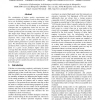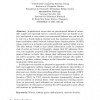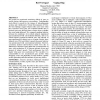1511 search results - page 14 / 303 » On the effectiveness of address-space randomization |
IOLTS
2000
IEEE
14 years 2 days ago
2000
IEEE
The combination of higher quality requirements and sensitivity of high performance circuits to delay defects has led to an increasing emphasis on delay testing of VLSI circuits. A...
CMS
2006
13 years 9 months ago
2006
Abstract. Sophisticated worms that use precomputed hitlists of vulnerable targets are especially hard to contain, since they are harder to detect, and spread at rates where even au...
ESOP
1999
Springer
13 years 12 months ago
1999
Springer
Safety of interoperation of program fragments written in different safe languages may fail when the languages have different systems of computational effects: an exception raised b...
ICASSP
2010
IEEE
13 years 7 months ago
2010
IEEE
Random projection has been suggested as a means of dimensionality reduction, where the original data are projected onto a subspace using a random matrix. It represents a computati...
CSCW
2002
ACM
13 years 7 months ago
2002
ACM
We present an experiment examining effects of gaze on speech during three-person conversations. Understanding such effects is crucial for the design of teleconferencing systems an...



